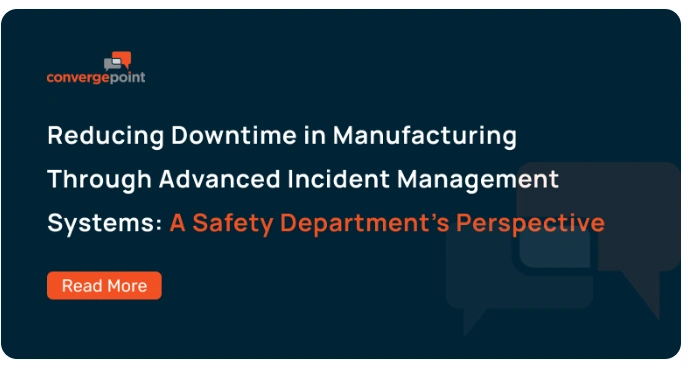Manufacturing environments rely on seamless operations to maintain output and profitability. However, unforeseen incidents—ranging from safety hazards and fraud to compliance breaches and operational disruptions—can lead to costly downtime. Effective incident management is crucial for preventing minor issues from escalating into production halts, regulatory fines, or reputational damage.
Safety managers and department leaders recognize that advanced incident management software, such as ConvergePoint on Microsoft 365, can significantly reduce these downtime risks. By integrating robust reporting, streamlined investigations, structured corrective actions, and real-time collaboration, such software transforms how manufacturers navigate incidents throughout their lifecycle. This article examines how a comprehensive incident management approach cuts downtime, fosters a safety-first culture, and ensures operational continuity.
The Importance of Incident Management in Manufacturing
Manufacturing plants often use complex machinery, handle hazardous materials, and function under strict regulations. Even a brief shutdown—caused by a safety concern, a suspicious financial transaction, or a compliance breach—can trigger substantial revenue loss, strained delivery schedules, and potential legal repercussions.
Downtime costs typically include lost productivity, emergency response expenses, potential expedited shipments for delayed orders, workforce overtime, or even lawsuits if negligence is claimed. Minimizing downtime isn’t solely about financial gains; it also protects brand reputation, keeps employees safe, and reinforces stakeholder confidence in the organization’s processes.
Modern incident management systems address these concerns holistically. They enable rapid reporting, structured investigations, root cause analysis, corrective action assignment, and final verification—all within a centralized platform. The result is a measurable reduction in unplanned downtime, consistent compliance, and a culture that values early detection and resolution of operational risks.
Case Types: More Than Just Workplace Safety
While safety incidents such as machine-related injuries or lockout/tagout oversights remain at the forefront, a robust approach must also handle other incident types:
1. Fraud Incidents Examples include suspicious financial transactions or inventory theft. These can disrupt production if critical materials go missing or budgets are misused.
2. Risk Exposures These might involve supply chain breakdowns, environmental hazards like chemical spills, or IT vulnerabilities affecting operational systems.
3. Compliance Breakdowns Failing to meet standards set by agencies like OSHA or industry-specific regulations can lead to shutdowns and fines.
4. Operational Disruptions Major equipment malfunctions, power outages, or sudden staff shortages can rapidly escalate into production bottlenecks.
An incident management system that addresses each category ensures wide-ranging coverage and quick resolution. ConvergePoint on Microsoft 365 accommodates these varied needs, enabling custom forms, workflows, and notifications tailored to the nature of each incident.
Specialized Incident Reporting Forms
Each incident type—whether safety, fraud, risk, compliance, or operational—demands a specific set of data to facilitate effective response. ConvergePoint incident management software on Microsoft 365 provides customizable, scenario-specific reporting forms, ensuring employees capture the right information from the outset.
- Safety Incidents: Forms may require details about location, protective equipment used, type of machinery, witness statements, and injuries sustained.
- Fraud Cases: Financial references, suspect transactions, invoice numbers, and related departmental contacts.
- Risk/Operational Disruptions: Facility location, impacted production lines, supply chain nodes, or relevant IT systems.
By guiding employees to complete relevant fields upfront, these incident forms streamline responses, reduce miscommunication, and provide management with consistent, actionable data.
The Role of Anonymous Reporting
In certain situations—such as suspected fraud or an unsafe workplace shortcut—employees might hesitate to file a report if they fear retaliation. Anonymous reporting alleviates these concerns, boosting transparency and early detection.
An incident management platform with an anonymous reporting option helps build trust and encourages employees to voice concerns without fear. This approach reveals hidden issues that, if ignored, can lead to extensive downtime or legal complications. A culture of open communication ultimately strengthens safety practices and reduces long-term risks.
The Incident Lifecycle in Manufacturing and How ConvergePoint Helps
Effective incident management follows a structured sequence:
1. Incident Reporting
When an incident occurs—be it a safety hazard, potential fraud, or an equipment failure—time is critical. ConvergePoint offers:
- Customizable Incident Forms: Employees select the relevant category (safety, fraud, risk, compliance, or operational disruption), then fill out dynamic fields specific to that scenario.
- Ease of Access: Manufacturing floor workers can access forms via desktops, tablets, or mobile devices, enabling immediate, location-based reporting.
- Anonymous Submissions: Optional anonymity promotes honest disclosure, vital for uncovering hidden issues.
How This Reduces Downtime: Quick reporting ensures immediate awareness of potential disruptions. Employees don’t waste time searching for the right form or worrying about repercussions, allowing managers to act fast before an incident escalates.
2. Automatic Routing
After submission, the system needs to direct the report to the correct person. ConvergePoint incident management software automatically forwards the incident to the relevant manager or department based on factors like:
- Facility Location: Incidents at Plant A may be routed to the Safety Manager overseeing that site.
- Department: Financial anomalies go to the finance/compliance team, whereas machine failures might go to maintenance and EHS.
- Incident Severity: Critical issues trigger escalations to higher-level authorities or specialized units.
Downtime Reduction: By eliminating manual forwarding chains or guesswork, the platform prevents miscommunication and shortens response times.
3. Manager Review
Once a manager or supervisor (often in the Safety Department) receives notification of a new incident, they can:
- Triage: Decide if immediate containment or other interim measures are needed (e.g., halting a specific machine temporarily).
- Initiate Next Steps: Determine whether a simple fix suffices or if a formal investigation is warranted.
Downtime Reduction: This prompt review helps management isolate or address the issue promptly. For instance, if a malfunction is severe, production lines can be re-routed, avoiding a total plant shutdown.
4. Investigation Phase
If the responsible manager finds the incident requires deeper scrutiny, an investigation is launched. ConvergePoint:
- Enables Secure Collaboration: Investigators from multiple departments can attach documentation, share photos, or add comments in a centralized case file.
- Tracks Progress: Real-time status updates show who is currently working on the investigation and whether any steps are pending.
- Minimizes Interruptions: Investigations proceed methodically without requiring indefinite machine shutdowns; managers and engineers focus on identifying only what truly needs stopping or replacement.
Downtime Reduction: By confining investigative activities to the impacted area or processes, the rest of the plant keeps running. Clear oversight of deadlines ensures investigations don’t languish in email inboxes.
5. Root Cause Analysis
After the initial investigation, the team identifies the fundamental reasons behind the incident:
- Equipment & Maintenance Records: If a machine breakdown is suspected, the investigator reviews maintenance logs or usage patterns, identifying potential oversights.
- Process & Policy Review: For compliance or fraud incidents, relevant procedures and policies are examined to spot loopholes or training gaps.
- Incident Trends: Historical data within ConvergePoint can highlight repeated issues, guiding more permanent solutions.
Downtime Reduction: Robust root cause analysis ensures the organization doesn’t merely treat symptoms. By targeting the actual source (e.g., neglected preventive maintenance or insufficient oversight), future incidents—and the downtime they create—are minimized.
6. Proposed Corrective Actions
Investigators then propose solutions or changes. ConvergePoint incident management software:
- Standardizes Recommendations: Investigators document each proposed action, linking it back to a specific root cause.
- Coordinates Multi-Level Approval: Safety managers, department heads, and possibly upper management can review and edit proposed measures.
- Logs Rationale: Each step is recorded in the system, providing an audit trail and reference for future incidents.
Downtime Reduction: Clear, approved corrective actions that align with identified root causes prevent repeated failures. This ensures a direct path from discovering an issue to resolving it, instead of interim, stopgap solutions that could lead to more downtime.
7. Assigning Corrective Actions
Once the solution plan is approved, the system assigns each task to individuals or teams:
- Automated Task Creation: ConvergePoint automatically sets deadlines and sends notifications to those responsible for each action (e.g., maintenance technicians, HR, procurement, or safety trainers).
- Progress Tracking: Real-time dashboards highlight whether tasks are on schedule or at risk of delay. Overdue tasks can trigger escalation rules.
Downtime Reduction: When tasks are clearly owned and tracked, there is no confusion about who is responsible. Timely corrections ensure fewer disruptions to daily operations.
8. Action Completion and Verification
Employees or managers assigned to corrective actions mark them as complete within the platform, potentially attaching photos or documents as proof (e.g., replacement part invoices, updated training materials). The responsible safety manager or designated validator reviews these completions:
- Confirm Effectiveness: If the fix resolves the root cause, the manager signs off on the action.
- Reopen If Necessary: If the manager identifies any shortfalls, they can request additional steps or reassign tasks.
Downtime Reduction: Verified solutions ensure that partial fixes or incomplete tasks don’t lead to repeated incidents, further plant shutdowns, or regulatory scrutiny.
9. Post-Incident Analysis & Reporting
Finally, the system archives incident details, making them available for:
- Trend Analysis: Repeated incidents in the same department or with the same equipment prompt bigger changes (e.g., upgraded machinery, refined training).
- Compliance Reviews & Audits: The digital record includes each step from reporting to closure, streamlining regulatory checks.
- Continuous Improvement Initiatives: Data-driven insights feed into Lean or Six Sigma projects, boosting overall operational excellence.
Downtime Reduction: By learning from every incident, the manufacturing facility lowers the likelihood of future disruptions. Persistent issues are flagged, and processes can be overhauled proactively.
Real-World Scenarios
1. Machine Failure on an Assembly Line
A conveyor belt shows signs of imminent breakdown. An operator quickly logs the anomaly in ConvergePoint using a specialized machine failure form. Automatic routing alerts the maintenance manager, who assigns an engineer to investigate. A root cause analysis reveals worn bearings. Corrective actions involve replacing bearings and updating preventive maintenance. By catching the issue early, the plant avoids a total line shutdown, reducing downtime significantly.
2. Suspicious Financial Activity
A procurement clerk anonymously reports irregular invoice patterns for spare parts. The system routes this to the compliance officer. Investigation uncovers a fraudulent vendor contract. Corrective measures include terminating the vendor, adding stricter oversight in the procurement process, and retraining the finance team. The quick resolution of fraud not only safeguards funds but also prevents future disruptions caused by missing or delayed critical components.
3. Chemical Spill in Storage
A small chemical leak is reported. ConvergePoint real-time alert triggers an EHS team response. Investigators secure the area, contain the spill, and trace the leak to improper sealing of containers. Corrective actions include updated storage protocols and enhanced employee training. Because the software quickly isolates the affected area, the rest of the facility continues operating with no major downtime.
4. Repetitive Motion Incidents
Multiple workers on a packing line report recurring wrist pain. Their near-miss forms indicate the same station as problematic. A safety department review shows inadequate ergonomic setup. Proposed corrective actions include adding adjustable height tables and instituting short breaks. This proactive intervention curtails potential injuries that could have led to lost productivity or permanent staff shortages.
Integration with Microsoft 365 and Its Impact on Downtime
ConvergePoint incident management software is built on Microsoft 365, leveraging tools like SharePoint, Teams, and Outlook:
- Familiar Ecosystem: Employees already accustomed to Microsoft tools adapt quickly, reducing training overhead.
- Real-Time Collaboration: Teams can exchange updates, chat in real time, and share documents or videos, accelerating closure rates.
- Secure & Scalable: Microsoft’s robust security features (role-based access, encryption, compliance certifications) protect sensitive data.
This approach offers a frictionless experience, amplifying the value of an incident management platform in minimizing operational disruptions.
Meeting Regulatory Requirements and Reducing Liability
Manufacturing plants often fall under multiple regulatory bodies. Non-compliance can result in forced shutdowns, significant fines, and damaging headlines. An advanced incident management platform:
- Maintains Audit Trails: Every action is automatically recorded with timestamps, ensuring transparency for internal or external audits.
- Enforces Policies & Procedures: The system helps ensure that required steps—like root cause analysis or immediate hazard containment—are followed.
- Facilitates Ongoing Compliance: If regulations change, forms and workflows can be updated easily. This adaptability keeps incident handling consistent with new rules, avoiding the risk of unplanned downtime from compliance shortfalls.
Continuous Improvement and Operational Excellence
Incident management is more than a reactive function. By systematically tracking and analyzing incidents—small or large—manufacturing operations develop a data-rich environment for continuous improvement. Some benefits include:
- Trend Identification: High occurrence of machine breakdowns in one area signals the need for either equipment upgrades or revised procedures.
- Targeted Training: Where data shows repeated compliance slip-ups, leadership can implement specialized training or refreshers for staff.
- Proactive Risk Mitigation: Early detection of potential issues—like suspicious behaviors or near-misses—prevents them from escalating, keeping production stable and safe.
When integrated into corporate strategies such as Lean Manufacturing or Six Sigma, advanced incident management becomes a cornerstone for building a culture of safety, efficiency, and cost-effectiveness.
Implementation and Change Management
1. Leadership Alignment: Executive support ensures that all departments understand the critical nature of implementing a robust system, thereby granting the necessary resources and attention.
2. Configuration & Customization: The organization works with ConvergePoint to tailor forms for each incident category. Multiple test runs ensure smooth integration into daily processes.
3. User Training & Engagement: Workshops or on-the-floor demos familiarize operators, team leads, and managers with the platform. Emphasis is placed on immediate, accurate reporting.
4. Iterative Feedback Loops: Pilot programs can gather employee insights, adjust workflows, and refine escalation chains. This approach guarantees the software fits seamlessly into plant operations.
5. Long-Term Maintenance & Upgrades: As legal frameworks evolve or new operational challenges arise, the system should be updated. ConvergePoint offers continuous enhancements to keep pace with the manufacturing sector’s changing landscape.
How ConvergePoint Dramatically Reduces Downtime Risks
1. Real-Time Alerts: Swift notifications ensure the right stakeholders act before small issues grow large.
2. Structured Investigations: Organized steps make certain that managers or investigators promptly isolate problems, so that only affected lines or departments are paused.
3. Automated Workflows: Eliminating manual processes removes bottlenecks and ensures everyone stays aligned on timelines.
4. Detailed Corrective Actions: Thoroughly addressing root causes prevents recurrences, helping maintain production stability in the long run.
5. Cross-Functional Visibility: Senior leaders, safety managers, engineers, and operators can view relevant data at any time, ensuring well-informed decisions that keep production going.
In manufacturing, safeguarding uptime is a core objective. Plants are intricate systems, constantly susceptible to disruptions arising from safety incidents, compliance missteps, fraudulent activities, or operational breakdowns. Adopting an advanced incident management system—such as ConvergePoint on Microsoft 365—empowers safety managers and department leadership to tackle every incident comprehensively, from initial reporting to final corrective action verification.
By tailoring incident forms to each case type, facilitating anonymous reporting, automating routing, and guiding each step of investigation, these platforms create a unified response that both mitigates and prevents future downtime. The result is a manufacturing environment where employees trust the incident handling process, managers can identify trends early, and decision-makers have the insights to continuously improve operational excellence.
Ultimately, robust incident management is more than just a safety measure; it’s a strategic business advantage. With consistent processes, real-time collaboration, and data-driven insights, manufacturers can minimize costly stoppages, meet regulatory standards, and foster a workplace culture that prizes proactive prevention and accountability.
Talk to a ConvergePoint incident management expert to learn more or request a demo.
Originally published at[
convergepoint.com](https://)











